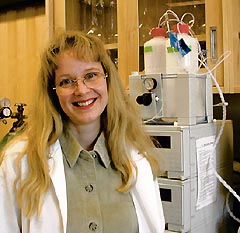|
This is an archived
article. For the latest news, go to the Advance Homepage
For more archives, go to the Advance Archive/Search Page. |
||
|
Research Takes Marine Scientist
Skoog, a native of Sweden, is an assistant professor of marine sciences at the Avery Point campus.
On the wall of her office are colorful certificates commemorating her initiation into the circles of investigators who have crossed the Equator and those who have explored the icy polar regions. Skoog is not always ensconced in extreme environments. She's also often found in her well-equipped laboratory at the Avery Point campus. It is there that she is working with doctoral student Elizabeth Svenson (also from Sweden), student Tyong Guen Chen, and post-doctoral associate Penny Vlahos. The team has developed new methods to detect certain organic matter - amino acids, sugars, and low molecular weight acids - in seawater. Organic Compounds "Global warming affects the Arctic before any other area in the world," says Skoog. "To predict what changes might occur due to global warming, we need to understand how the system works now." While studying the global carbon cycle from different perspectives, Skoog has found many similarities as well as many differences in the ocean systems of the Arctic and the Antarctic. Dissolved in seawater, the carbon-containing compounds are a rich energy source for microbes. This dissolved organic matter is particularly abundant in the icy Arctic Ocean, yet much remains to be learned about it and how it behaves under various conditions. Skoog and her graduate students are striving to learn more about the importance of these molecules and how they move through rivers into the ocean or are generated within the ocean itself. But performing such investigations is not an easy task. Most existing analytical detection methods are not sensitive enough to discern concentrations of specific molecular compounds in seawater, and are also easily contaminated. So Skoog and her graduate students are putting a lot of effort into developing new, improved methods that will, among other things, help to more accurately quantify the organic matter. One of the methods she has developed detects certain sugars, called aldoses. "Method development can be both tedious and frustrating, but it is nevertheless essential because it provides scientists with the tools to do their research," says Skoog, whose work has received support from the National Science Foundation. Fire and Ice Skoog can move from frost to fire. One of her projects involved sampling the superheated waters from undersea hydrothermal vents, hot springs on the ocean floor that occur along active volcanic ridges when magma escapes to the surface in steaming plumes. With colleague Jan Amend, she has recently started work off the island of Sicily, Italy. The Sicilian vents are part of an unusually shallow vent system that can be sampled by Scuba diving. She has also sampled deep-sea vents, where black smoker "chimneys" arise from the seabed. Skoog studies the organic matter in the superheated fluid that enters the ocean as a result of volcanic activity and serves as the energy source to diverse bacteria that can survive even the most extreme conditions. Unusual creatures, such as seep worms and giant tube worms, are supported by the bacteria in these inhospitable places. New life forms - at least ones that have never been seen or described - are still being discovered in these mysterious vents. Skoog's vent work may help change the existing scientific paradigm, which suggests that hydrothermal bacteria mainly use inorganic matter for energy. Skoog believes it's likely they use the organic matter she's found in her samples. Light and Heat They hope to find out what effects the energy conversion has on the organic matter. Skoog and Vlahos think sonoluminescence may play a role in many marine environments on Earth, including hydrothermal vents, although its study is still a new and somewhat controversial scientific pursuit at the moment. |
 s a marine
biogeochemist, Annelie Skoog's scientific quests have led her to
traverse the globe from Pole to Pole, from the forbidding frozen ice
floes of the Arctic and Antarctic, to the hottest spots on Earth -
the steaming hydrothermal vents beneath the ocean floor.
s a marine
biogeochemist, Annelie Skoog's scientific quests have led her to
traverse the globe from Pole to Pole, from the forbidding frozen ice
floes of the Arctic and Antarctic, to the hottest spots on Earth -
the steaming hydrothermal vents beneath the ocean floor.
